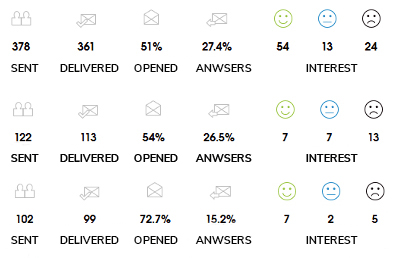Does cold mailing still make sense in 2020?
Artykuł gościnny
This article will teach you more about cold mailing. You’ll learn the answer to the question of what cold emailing is, who should use it, and what to do to make it effective. Also, we’ll check, based on examples, whether in 2020 (and during the coronavirus pandemic) this marketing channel still yields returns.
Methods of customer acquisition
Those responsible for sales surely know the moment when they need to get new customers. When companies are running out of leads, they can resort to one of the two approaches to generating new contacts:
inbound marketing, where you bring potential customers to your company. To give you a basic idea, this includes paid advertising (Google Ads, Facebook Ads), content marketing, and SEO; and
outbound marketing, i.e., activities in which you proactively approach potential customers. The tools used in this kind of marketing include cold emailing, cold calling, and social selling. As promised, this article will focus on cold emailing.
What’s a cold email?
Cold emailing is a form of acquiring new customers, where you directly contact people you have never talked with. As part of prospecting activities, i.e., when searching for potential customers, you select the companies you’re interested in. Next, you contact the relevant decision-makers in order to establish a relationship. Many people confuse cold emailing with email marketing (e.g. newsletters). Email marketing and newsletters are simply activities aimed at people you already have in your database. These two seemingly similar activities are very different.
Who should use this channel?
Cold emails will surely work well in the case of B2B companies if you want to quickly add medium and large players to your customers. Quite often, representatives of such companies don’t look for new solutions or suppliers, so it’s good to get to them directly. Companies that choose this channel should generally deal in ‘appropriately-priced’ products and services. Cold emailing is a more expensive channel than Internet marketing and you really need to bear this in mind in order to achieve a proper return on investment. Your product range should reach amounts of at least several thousand złoty at a time, or have a high LTV (Lifetime Value), i.e., generate lower (e.g. by several hundred złoty) but repeatable revenues.
Why is cold mailing worth using?
The biggest advantage of cold emailing is strict control over who you contact. In the case of inbound marketing, you unfortunately don’t always know who’ll click on your ad or read your blog post. But here, you know exactly who can read your cold email. If you’re interested in reaching the purchasing director of a large chain of wholesale outlets, there’s no better way than to contact him/her directly. Unfortunately, the chances of your ad being clicked exactly by the person you’re looking for are slim. Also important in this channel is the short time needed to reach decision-makers. You can start talks with them within a week or two. Inbound marketing, on the other hand, is a long-term strategy.
Another significant aspect to consider is what distinguishes cold calling from cold emailing. I know from experience that, for many people, a sudden unannounced call from a salesperson eager to make a sale is the worst thing that can happen to them. What’s more, in the case of large companies, you very often come across the so-called gatekeepers, that is, secretaries who effectively block your access to decision-makers. With a cold email, you completely bypass the reception desk and get straight to the decision-maker you’re interested in. If you show this person that thanks to your company they will achieve their objectives, it’s very likely that they’ll want to get to know your offer. In the case of small companies, cold emailing may be more effective too because a potential customer can see your email at a time that’s convenient for him/her, get acquainted with it in peace, check your company out, and only then decide whether he/she wants to talk to you.
What to do to make cold mailing effective?
First of all, effectiveness of cold emailing depends on whether you choose the right target group. A well selected size of the company, industry, and position of the decision-maker are crucial. After all, you don’t want to write about strategic advice on production to a company that’s a small distributor of painting tools. This point is also connected with product/market fit – the existence of a problem you want to solve. A large production company has different problems from a small production company. Which one’s needs are you responding to?
The second important element is the right content. The subject of the message should be interesting, but not misleading. As regards the content itself, it must be short and specific. There’s nothing worse than a lengthy email starting with “my name is X, I am the owner of company Y…”. Your content should end with a clear Call to Action. This could be a question about when you’ll be able to discuss the potential for cooperation, or about a detail that’s important to you as the author of the message, e.g., “is this issue currently important to you?”.
The next point should certainly be a legitimate reason for contact. This is important for both effectiveness and the legal side of things. You must have a clear and specific purpose for which you’ve decided to contact the customer. This could be the situation on the market (e.g. the coronavirus pandemic), a post on the blog of the given company, or some detail that distinguishes their industry.
The last (but not least) point is the follow-up. In order words, not letting yourself be forgotten. Quite often, sending one message is not enough. Your email may get lost in the jumble of others. This is why it’s good to send another email every 3–4 days, in which you’ll add more values (e.g. send a case study concerning a similar customer, or add more benefits of working with you). In my experience, it’s best to send 3 to 5 messages, that is, 2–4 follow-ups after the opening email.
Data sources
Where can you find the decision-makers you want to reach? The most commonly used data sources are:
– LinkedIn,
– GoldenLine,
– company websites,
– industry press,
– trade associations,
– the National Court Register (KRS).
The above sources will give you direct addresses of specific people (e.g. in the case of some companies, they are available on websites) or the names of the decision-makers of interest to you (e.g. from LinkedIn or KRS). Next, you can compose an email to the given person based on the template of emails of other people at the company.
Does cold mailing make sense these days?
In 2020, cold emailing is still a valuable source of new leads. But, while you’re at it, you need to use your common sense – as I wrote above in the part about effectiveness. Below there are three examples of customers from different industries (IT, HR, and production) showing that it’s still a great source of leads:
Number of sent and delivered messages, number of opened messages, number of replies and classification of replies by interest
Has COVID-19 affected the results of such campaigns? Serving many industries – including production, IT, HR services, consulting services, and marketing agencies – we can see that COVID-19 hasn’t had a negative impact on the effectiveness of this channel. In many cases, the coronavirus situation has even increased its effectiveness, as many people have opened up to online contact, video calls, and remote working, which is conducive to the use of cold emailing.
Other posts

Turning ‘No’ into ‘Yes’: How to Convince Your Customers to Buy from You?

Sell Wiser, Not Harder. 3 Key Steps to Master Sales Automation







